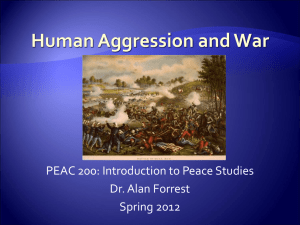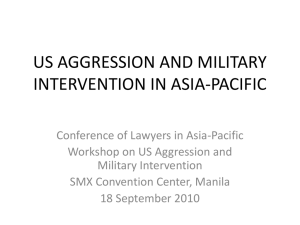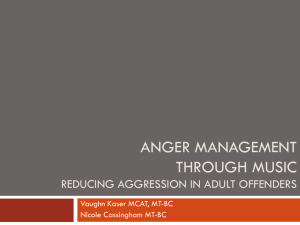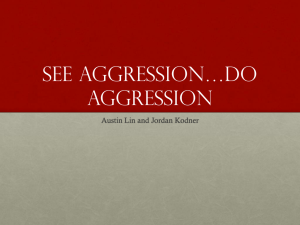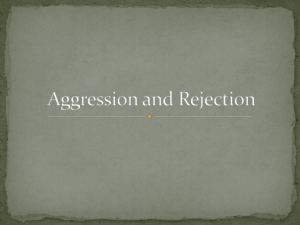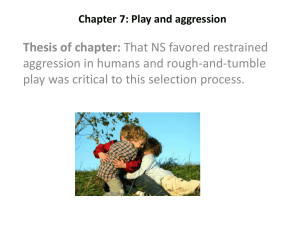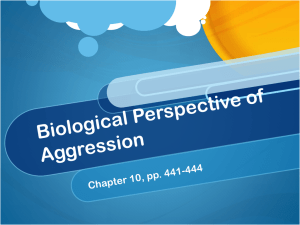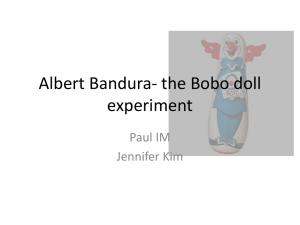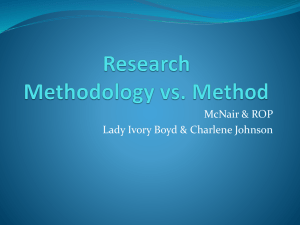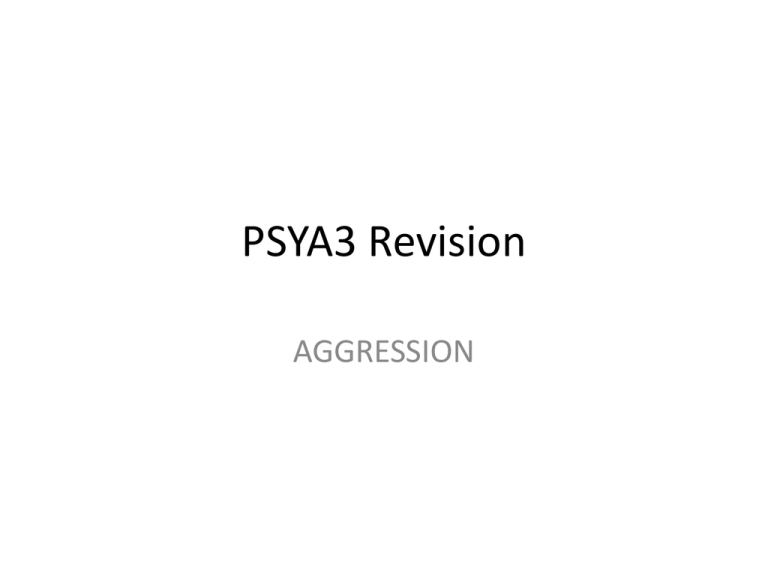
PSYA3 Revision
AGGRESSION
Syllabus
Social psychological
approaches to explaining
aggression
Biological explanations of
aggression
• Social psychological theories of aggression, (social
learning theory, deindividuation)
• Explanations of institutional aggression
• The role of neural and hormonal mechanisms in
aggression (testosterone, serotonin, frontal lobe
abnormalities)
• The role of genetic factors in aggressive behaviour
(Family Studies, XYY, MAOA)
Aggression as an adaptive
response
• Evolutionary explanations of human aggression,
including infidelity and
jealousy
• Explanations of group display in humans, for
example sports events and lynch
mobs
Discuss social
psychological theories of
aggression
•
•
•
SOCIAL LEARNING THEORY
Observational learning
4 Requirements before imitation
–
–
–
–
•
•
A_________
R______
M______ (V_________ Reinforcement)
R______
Characteristics of model are key. We
will imitate aggressive models who
are... For e.g…
Classic mistake made by students
when ‘describing’ the theory?
•
•
•
EVALUATION
Evidence – Bandura’s studies
Commentary – operationalisation of
aggression; sample issues; ecological
validity
•
Incomplete and Behaviourally /
environmentally deterministic which
may have moral implications
NOMOTHETIC and too simplistic
(focus on nurture)
•
•
•
•
•
Alternative bio explanations are more
parsimonious and need to be
recognised for a more complete
explanation. For example…
Diathesis – Stress = most complete
Practical and theoretical applications
– e.g?
Culture specific
Discuss social psychological
theories of aggression
•
•
•
•
•
2. Deindividuation
When an individual becomes part
of a group they become
A_____________
There is also a D______ of
R_________ across the group
This leads to dis-inhibited,
impulsive behaviour such as
aggression and less concern about
personal / social morals and rules
and disapproval (which also
increases the likelihood of
aggression)
Deindividuation can be further
stimulated by contextual factors
(e.g...) so if these are present in a
situation, aggression is more likely
•
•
EVALUATION
Evidence – MUST BE APPLIED
–
–
–
•
Commentary
–
•
–
•
Artificial, ethnocentric, sample issues, etc
Incomplete and Deterministic
–
•
ZIMBARDO
Diener
Watson
most times crowds are not aggressive (give
an e.g.)
Sometimes people are aggressive when
they are easily identifiable
Deterministic and too simplistic on its
own (focus on Nurture) - alternative
(bio) explanations need to be
considered such as...
Diathesis – Stress = most complete
•
Deindividuation does not always lead to
aggression (Gergen’s dark room study
to support?)
•
Major PRACTICAL APPLICATIONS
–
E.g…
Neural and Hormonal Mechinisms
• TWO hormonal mechinisms
– SEROTONIN
– TESTOTERONE
• NEURAL mechanisms = abnormalities /
damage to the brain
– FRONTAL LOBES, Hypothalamus, amygdala
• CLAIM -> ELABORATION -> SUPPORTING OBSERVATION
Discuss the role of neural and hormonal factors in aggression
1. TESTOTERONE
• Claim – There is a link between
androgens, specifically high levels
of testoterone and aggression
•
•
•
•
2. SEROTONIN
• Claim – Low serotonin action =
aggression
•
Elaboration – This makes sense as
testosterone is the principle male
sex hormone and in all cultures
males demonstrate higher
aggression
Support - Castrated Mice (NB.
Castration significantly lowers
testosterone) leads to...
Injecting testosterone into
castrated mice does what...
Anabolic steroids and ‘roid rage’…
Elaboration – Makes sense as
serotonin has an inhibitory function
for impulsive aggressive acts.
– Also, you could explain what could
cause low serotonin…
•
Support – SSRI (serotonergic) drugs
clinically raise serotonin (by
preventing re-uptake) and… (e.g.
often used with institutionalised
juveniles)
Discuss the role of neural and
hormonal factors in aggression
EVALUATION
• Evidence – LOTS!
• Commentary
– Methodological strengths –
objective measures, Purely
correlational, case study problems ,
Methodological reductionism and
low ecological validity
– Extrapolation
– Problems with the measurement of
aggression (inconsistent)
3. NEURAL FACTORS
• Claim – aggression could be due to
neuroanatomical (brain)
abnormalities, e.g. As a result of
accidents
•
•
Elaboration – Specific brain areas
which have been implicated include
the hypothalamus, Amygdala and
Pre-Frontal Cortex
•
Objective and testable / scientific
•
‘hard’ determinism which has
moral implications
Parsimonious but Too Simplistic and
Incomplete
– Explain the function of these and
why they have been linked to
aggression
•
Support – PHINEUS GAGE - damage
to the PFC as a result of… following
his accident he became...
•
•
Alternative non-bio explanations
Diathesis – Stress = most complete
•
But... Key practical applications
GENETIC factors and Aggression
• General claim is that aggression is caused by inherited
genetic abnormalitites
• Same structure as neural / hormonal
• CLAIM -> ELABORATION -> SUPPORTING OBSERVATION
• Four possible content areas
–
–
–
–
SELECTIVE BREEDING
FAMILY STUDIES
XYY
MAOA
• This essay ‘builds’ quite nicely…
Discuss the role of genetic
factors in aggression
1. SELECTIVE BREEDING
•
LAGERSPETZ – Aggressive mice can be
developed through SELECTIVE
BREEDING… (explain this). Demonstrates
that aggression can be passed through
genes
–
But… Extrapolation issues;
operationalisation of aggression is too
specific (‘biting behaviour’)
2. FAMILY STUDIES
• Evidence that aggression tends to run in
families
–
McGUE - .43 concordance for aggression
across MZ twins but onl 0.3 across DZ
twins. Suggests a role of genetics but…
•
–
But shared environment criticism;
operationalisation of aggression…
MEDNICK – Danish Study found crime
convicitions were most likely in boys who
had both biological AND adoptive parents
with convictions. Suggests a role of both
NATURE and NURTURE
So the next stage for researchers was to try
and identify SPECIFIC genetic abnormalities
which lead to aggression
3. XYY Chromosome Defect
• 1:1000 males – gives males an extra
chromosome.
• Increased testosterone, impulsivity – link
to aggression is clear
• Defect as high as 3% in prisoners
•
HOWEVER… 26,290 candidate genes on
this extra chromosome
4. MAOA-L genetic variation
• MAOA regulates an enzyme which
removes the build up of serotonin,
dopamine and noradrenalin, allowing
brain cells to communicate more
effectively.
• The abnormal MAOA-L variant prevents
production of MAOA enzyme which leads
to a build up of these chemicals, causing
abnormal neuronal communication,
resulting in aggression.
•
EVIDENCE from BRUNNERS study into a
Dutch family…
Discuss the role of genetic factors in aggression
EVALUATION
• PLENTY OF EVIDENCE
• Commentary = Shared environment and twin studies; Extrapolation;
Unrepresentative case studies; Problems with the measurement
(operationalisation) of aggression; Correlations not cause and effect
• HARD DETERMINISM and must be incomplete because…
– NB. Could also mention how XYY/MAOA-L does not explain FEMALE
aggression (gender bias)
• TOO Simplistic – Alternative Social-Psych theories need considering too
(briefly explain 1).
• DIATHESIS – STRESS offers the most complete explanation
• MORAL IMPLICATIONS because… BUT may have PRACTICAL APPLICATIONS
because…
Institutional Aggression
• USE WHAT YOU KNOW!
• Outline / Discuss Explanations For Institutional
Aggression
• Outline / Discuss research into institutional aggression
– Same question; describe and evaluate situational,
dispositional, interactionist THEORIES BUT make sure you
apply them to e.gs of institutional aggression
• Outline one example of institutional aggression
– Identify and example (e.g. Abu Gharib, prison riots),
outline the aggression, apply theory to explain BRIEFLY!
Discuss explanations of Institutional Aggression
SITUATIONAL
• The environment within
the institution causes the
aggression (bad barrels)
DISPOSITIONAL
• Aggression is imported
into the institution (bad
apples)
– Deprivation of needs
(e.g.?) causes frustration =
aggression
– Deindividuation (the
institution must be set up
for this e.g. Through the
use of...)
– Conformity, SLT (when one
person is aggressive…)
– Genetic and neural
abnormalities (see
previous notes
– Race, background (think
about the Attica prison
riots)
CONCLUDE with reference to INTERACTIONIST theories e.g.
DIATHESIS - STRESS
Discuss explanations of Institutional Aggression
EVALUATION
• A little tricky – make sure you APPLY
• Evaluate each ‘general’ theory (situational,
dispositional)
•
•
•
•
Some evidence
Theoretical Applications
Practical Applications
Deterministic, Incomplete and too simplistic – explain
with reference to institutional aggression
• An ‘interactionist’ conclusion is good evaluation
Evolutionary Explanations
• Always refer back to evolution, e.g. increased
chances of S_________ and R___________
• May be asked SPECIFICALLY about the role of
infidelity and sexual jealousy – WATCH OUT FOR
THIS!
• Can include reference to infidelity and sexual
jealousy in a ‘general’ essay on evolution and
aggression
Evolutionary Explanations
BASIC EVOLUTIONARY THEORY
• Basic CLAIM – Aggression has evolved
through natural selection as it is an
adaptive behaviour (provides increased
chances of SURVIVAL and REPRODUCTION
• ELABORATION - Increase Survival includes
protecting / gaining resources
• Increased Reproduction chances – displays
of aggression establishes dominance over
competitors and provides STATUS in a
group which is attractive; aggression
PROTECTS relationships (controls
partners);
• EXTENSION - Different types of aggression
in males and females? Aggression may be
‘TACTICALLY CALCULATED’
• SUPPORT – aggression can be seen in all
cultures (it universal), which is loose
evidence of its evolutionary basis
ROLE OF JEALOUSY and INFIDELITY
• CLAIM - Infidelity poses different RISKS /
THREATS to males (CUCKULDRY) and females
(withdrawal of RESOURCES). These REDUCE
chances of successful genetic transmission
through offspring
• Aggression may therefore be a response to
PROTECT a relationship and INCREASES
chances of genetic transmission
•
CLAIM - JEALOUSY may be an EVOLVED
EMOTIONAL STATE which is triggered by the
THREAT of infidelity. Jealousy may lead to
aggression as a way to reestablish / protect
the relationship and thus increase chances of
genetic transmission
•
Could mention difference between sexual
and emotional infidelity / jealousy and how
this impacts on males and females
•
Could Mention specific types of Phys / Verbal
Aggression used by males and females to
protect a relationship / enhance chances of
genetic transmission (MATE RETENTION
TACTICS)
Evolutionary Explanations
- Evaluation
•
Evidence and Commentary (ethical ways to investigate aggression? Problems with
data collection; sample issues)
– E.g. Chagnon and the Yanomamo tribe (who got the best women?)
– Shackleford’s research into Mate Retention
– Research into infidelity and jealousy and sources of aggression
•
•
Unfalsifiable and Post Hoc
Less reductionist as it takes into account biological and past environmental
pressures but could still be too simplistic as it ignores the role of contemporary
pressures. Alternative explanations emphasise ‘here and now’ such as SLT
(summarise briefly)
•
Very Deterministic and serious moral implications (male mate retention behaviour
a justified response to threats due to evolution?);
Must be incomplete as some people do not respond with aggression even when
resources are threatened
•
•
•
Some practical applications – knowledge can be used to identify the early stages of
aggression and prevent progression to more serious aggression
Not gender bias – recognizes the differences between males and females and
explains the different types of aggression seen in each
Evolutionary Explanations of Group
Displays of Aggression
• Must use Evolutionary theory to explain WHY
aggression occurs in groups
• Remember – being in a group INCREASES
chances of survival and victory!
• Outline one example of a group display of
aggression
– Identify one example you have studied, explain
the aggression and apply theory to explain it!
Evolutionary Explanations of group displays
of aggression
POWER – THREAT HYPOTHESIS
• Aggression is an evolved response
to a perceived threat to a groups
dominance by a growing minority
• Aggression is used to re-establish
dominance / suppress the threat
• Group aggression makes
evolutionary sense as it offers the
greatest chances of SURVIVAL
• Could mention social cohesion
and the use of dehumanisation
and legitimising myths
SOCIAL DOMINANCE
• An extension / addition to PowerThreat
• Aggression is a way to maintain
established SOCIAL HIERARCHIES
• Aggression is a result of
challenges to these hierarchies
• Group aggression will allow
access to the resources of the
other groups!
Applied examples include warfare, lynch mobs, sports teams and crowds? (Egyptian
football riot is a nice contemporary example)
Evolutionary Explanations of Group Displays of Aggression
- Evaluation
•
Evidence and commentary (NB. Always apply to group displays of aggression not just to
aggression in general!)
–
–
–
Chagnon – warrior groups who use aggression were more successful (increased survival) and were
also provided with the best resources (women) as a reward
Blaylock and surveys about lynching found they were most common in times of economic and
political upheaval, suggesting group displays of aggression like lynchings are a way to reestablish
social hierarchies and group dominance
Clarke contradicts (victims of lynchings were NOT a political or economic threat)
•
Theoretical Applications – can be used to explain historical examples of group
aggression
•
•
Unfalsifiable and Post-Hoc;
Less reductionist than other theories but ignores contemporary influences such as the
role of technology which may trigger / contribute to aggression (e.g. Use of social
networking in the recent riots to coordinate / trigger the group aggression)
•
Deterministic and must be incomplete (some groups are not aggressive, even when
threatened – student protests? Ghandi and his followers? Mela Festival)
Alternative explanations of group displays
•
–
–
SLT, De-individuation (many groups are constructed to allow de-individuation (e.g. Uniforms of the
KKK); use Rothenberg to critique – most lynchings occur in the daylight which reduces anonymity)
Conformity – maybe aggression occurs in groups because people are simply conforming due to
normative influence and a fear of opposing?

